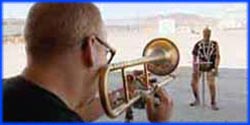


Premier Date: November 11, 2012
busted
This myth came from a scene in the TV series Burn Notice, in which the hero throws a hotel mattress from a balcony into a 4.5 ft (1.4 m) deep swimming pool and safely jumps onto it from 35 ft (10.7 m). Adam and Jamie began testing this scenario using a dummy with an accelerometer placed in its chest. When Buster, the dummy, was dropped butt-first into the plain water, he experienced 50g on impact with the water and another 29g impact with the bottom of the pool. When he was dropped onto an innerspring mattress, he experienced a deceleration of 86g. With 50g as their benchmark for lethality, neither drop appeared to be survivable.
To get even better results from their tests, Adam and Jamie repeated the drops using a sophisticated simulated cadaver. An orthopedic surgeon was also brought in to evaluate the damage using a portable X-ray machine. In the plain water fall, the simulated cadaver suffered a shattered pelvis and a paralyzing spine injury. When falling onto the mattress, it had far more damage all over, and as Jamie described, was “even more dead”.
At this point the myth was busted, but the duo wanted to see if skilled human jumper could possibly survive the jump. They brought in a stuntman who demonstrated that a normal, feet-first jump from 35 ft carried him to a depth of about 12.5 ft (3.8 m). The stuntman began training Jamie with techniques to reduce the depth of his entry. After a day of practicing jumps from increasing heights, Jamie deferred the full-height jumps to the stuntman due to soreness and concern for further injury. Ultimately the stuntman was able to jump from the full height while only dipping a few inches below the 4.5 ft mark, which Adam and Jamie reasoned would be a survivable impact had the pool only been that deep.
plausible
The Build Team began by firing an iron cannon ball from Civil War-era cannon loaded with 1 lb (0.45 kg) of black powder. They measured its velocity at 1,200 ft/s (366 m/s) and used that for a benchmark when calibrating their other shots. When the team began tests with a self-made cannon that they had previously used for other myths, a misfire sent a cannonball into a residential neighborhood in California, an event that made national news and postponed their filming.
The team resumed their testing several months later. They made cannonballs out of three different types of stone: sandstone, limestone, and granite. They changed their testing location to a remote rock quarry and decided to use the Civil War cannon for all of their shots. They calculated how much black powder each type of ball needed to match the velocity of the iron ball and fired one test shot for each. To simulate castle ramparts, they used pallets of large concrete bricks. The iron ball penetrated 2 layers or bricks and damaged 4 layers. The sandstone ball penetrated 1 layer, damaged 2 layers, and disintegrated. The limestone ball penetrated 1 layer, damaged 3 layers, and disintegrated. The granite ball caused the same amount of damage as the iron ball and also mostly disintegrated, making this myth plausible.
Previous: Episode 194: Mini Myth Medley
Next: Episode 196: Food Fables